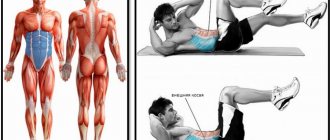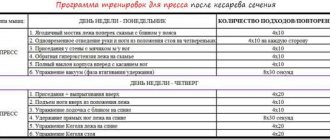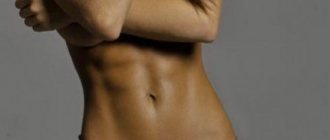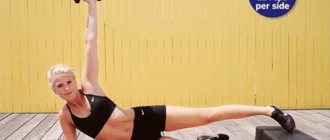Author: Tkachenko Sergey - master of sports in bodybuilding | more details >> Master of Sports of Ukraine in bodybuilding, coach. Finalist of the IFBB European Championship Moldova, Chisinau 2013. Champion of Ukraine in the category up to 70 kg. 2011. Multiple winner of the Ukrainian championships in bodybuilding and bench press. Senior moderator of our site.
Place in the ranking of authors:
5
(become an author)
Date:
2018-10-11
Views:
18,094
Rating:
5.0
| All articles by the author >> | Medals articles >> |
Articles are loading...
A little anatomy
The abdominal muscles include four muscle groups, two of which are external and two are internal.
External muscles include the rectus abdominis and external obliques , which form the well-known 6-pack. And the internal abdominal muscles include the transverse and internal oblique muscles , which create a kind of muscular frame that allows us to tightly hold our internal organs, as well as tighten our waist, making it narrower. Thus, their actions can be compared to the principle of a tightened corset, which makes our figure sporty and graceful.
The essence of the problem
The diagnosis of diastasis of the rectus abdominis muscles is heard after childbirth in about forty percent of women. This problem is quite common. What is diastasis? This is a complication after childbirth, as a result of which a woman’s linea alba expands.
Under the influence of fetal pressure, the abdominal muscles in the upper part literally move apart from each other. There are norms for such a discrepancy - this is one and a half to two centimeters. But there are cases when the distance between the rectus muscles can reach 10 centimeters. This is diastasis.
Myths about abdominal muscles after childbirth
The Internet boasts a huge amount of fake, false and unconfirmed information. Moreover, it can be presented in such a way that even the calmest woman will shake with fear.
This is what the normal location of the rectus muscles and diastasis looks like
Women have always paid special attention to their health and beauty, so they often take horror stories from the Internet on faith. They overthink themselves, inventing non-existent problems for themselves and driving themselves into depression with negativity. Therefore, it is worth dispelling the most common myths about diastasis.
Myths about diastasis:
- You may develop a hernia or prolapse of your intestines.
- The abdominal muscles atrophy.
- You will have a hanging belly for the rest of your life.
- Causes pain.
- Changes the structure of muscles and tissues.
All these theses are untenable. If you see that someone claims the opposite, run away from such an interlocutor. If you are really nervous about diastasis, go for a consultation with a specialist. He will answer all questions and reassure you. Never diagnose yourself!
When choosing a doctor, also beware of bad specialists. Some doctors, most often representatives of budget and government clinics, do not have the proper level of tact to communicate with a woman who has recently become a mother. Such new mothers already have a huge number of reasons for frustration. There is no need to add the bad attitude of the doctor.
How to determine diastasis?
Before we move on to consider practical recommendations and exercises against diastasis , you must first determine whether you have it or not. To do this you need to do the following test:
- Lie on your back, bend your knees (feet on the floor).
- Place one hand behind your head, and place 2-3 fingers of the second hand along your entire midline at the level of your navel, parallel to your waistline.
- Raise your head off the floor, feeling your abdominal muscles tense.
- Begin to feel the entire midline with your fingers, moving up and down from the navel line. Record how many fingers fit between your abdominal muscles.
If a gap has not formed and your abdominal muscles have not formed a “hole,” then you do not have diastasis, congratulations! If you feel that your abdominal muscles have moved apart, and a depression several centimeters wide has formed between them, then you have diastasis of the rectus abdominis muscles .
Precautions for postpartum diastasis
When the abdominal muscles diverge after childbirth, it is necessary to pay attention not only to the exercises performed, but also to everyday physical activity.
- When coughing, laughing, or sneezing too much, support your abs with your hands and apply gentle pressure to avoid putting unnecessary pressure on your abdominal muscles.
- Do not lift heavy things over 5-6 kg.
- Lift things weighing less than 5 kg with your arms bent at the elbows (not straight!). When picking things up from the floor, squat rather than bend.
- When rocking your baby, wear a postpartum bandage or tighten the tummy with an elastic bandage.
- Sleep on your side/back (not your chest!).
- Before getting out of bed or lying on it, roll over onto your side. And get up from the “lying on your side” position.
- Before getting up from the chair, you need to shift your weight to your left or right buttock and pull in your stomach. Stand up primarily using your legs, without straining your abs. You can push off with your hands.
Causes
Of course, diastasis cannot occur on its own. Its appearance is influenced by several factors:
- increased intra-abdominal pressure (lifting heavy weights, straining)
- weakness of connective tissue, which is caused by diseases such as hernias, varicose veins, excessive mobility of joints and ligaments, etc.
- pregnancy.
In this article, we consider diastasis of the rectus abdominis muscle , which is associated specifically with the last factor, which concerns almost all women - expectant and present mothers.
In pregnant women, as the fetus grows, the uterus also increases in size, which increases pressure on the abdominal wall, stretching the connective tissue (linea alba), which, under the influence of the hormone relaxin, becomes softer and more elastic. The hormone relaxin is secreted by pregnant women in order to make their ligaments and joints more mobile, which helps women give birth more easily, but at the same time it makes the connective tissue that makes up our white line of the abdomen overly elastic. It turns out that the hormone relaxin contributes to the appearance of diastasis in pregnant women.
These two factors - increased pressure of the uterus on the abdominal wall and excessively elastic connective tissue - are the main reasons for the appearance of diastasis after childbirth.
But in fact, there is no need to immediately fall into despair and postpartum depression if you discover diastasis immediately after childbirth. This phenomenon is absolutely normal. Most mothers who have given birth have a discrepancy between the rectus abdominis muscles, which normally should not exceed 2 cm. That is, if the width of your white line within 1.5 months after birth is at around 2-3 cm, then this is absolutely normal (we have already explained the reasons determined). During this period, you just need to do strengthening exercises for the abdominal muscles, which I will talk about below, and just wait for the muscles to tone up and the distance to shorten on its own.
If the muscle discrepancy exceeds more than 3 cm (3-4 fingers can easily fit between the abdominal muscles that move apart), then you should take a more serious approach to solving this issue and use the exercises below to reduce your diastasis, since there is a high probability that he himself will not disappear so easily.
What is it and why does it appear?
As a rule, diastasis occurs in pregnant women as a result of increased stress on the abdominal muscles during pregnancy. In rare cases, it may be caused by a genetic predisposition, weak abdominal muscles, or heavy physical activity.
The degree of development of diastasis is determined by the width of the muscle divergence:
- 1st degree – discrepancy 2-5 cm;
- 2nd degree – discrepancy 5-7 cm;
- Grade 3 – discrepancy more than 7 cm.
Based on the location of the discrepancy, it is divided into 3 types:
- above the navel;
- under the navel;
- mixed type (both above and below the navel).
Photo and schematic representation of the divergence of the abdominal muscles after childbirth:
Stages of diastasis
Stage 1 – slight expansion of the linea alba, which has virtually no visual effect on the shape of the abdomen (divergence of the rectus abdominis muscles up to 4-5 cm).
Stage 2 – divergence of the rectus abdominis muscle in its lower section. At this stage, a protruding tummy is already noticeable, especially in its lower part (the divergence of the rectus abdominis muscles is up to 7-10 cm).
Stage 3 – divergence of the rectus abdominis muscle, both in the lower and upper sections. This already significantly affects the shape of the abdomen, plus it can cause the appearance of an umbilical hernia (divergence of the rectus abdominis muscles up to 15 cm).
Types of diastasis
With the first stage of diastasis, you can very quickly and without surgical intervention return the prenatal shape of the abdomen, especially if the girl was involved in sports before giving birth and during pregnancy.
If a girl has stage 2 of diastasis, then special abdominal exercises + proper nutrition will help her significantly reduce the size of the diastasis within 7-10 weeks. And if a girl has stage 3, then most likely it will not be possible to get rid of diastasis so easily. Perhaps it makes sense to resort to surgery and do abdominoplasty (tightening the rectus abdominis muscles), but even such a radical method does not always promise to return you to a 100% flat stomach, and the cost of this procedure is not the cheapest... Therefore, the choice here is up to the woman and depends on her financial situation and the degree of her desperation.
Why does diastasis of the abdominal muscles occur and who is at risk?
The main cause of diastasis is weakness of the transverse abdominal muscles. But the following factors contribute to its occurrence:
Diastasis has no favorites. It occurs in men, women, and children. Especially often among athletes: weightlifters and weightlifters. All women in the third trimester of pregnancy experience some degree of divergence of the rectus abdominis muscle. For newborn children, diastasis is normal. It’s just that the connective tissue in babies is not yet strong enough and cannot serve as a reliable frame.
How to get rid of diastasis yourself?
Diastasis of the rectus abdominis muscles is a very serious problem for all women, causing them both external (aesthetic) discomfort in the form of a protruding abdomen (sometimes it seems that they are 3-5 months pregnant, their belly protrudes so much) and internal (moral) ) discomfort, which affects their self-doubt and low self-esteem.
Therefore, it is not surprising that girls who are faced with this problem want to get rid of it by any means. To do this, they search for various videos on the Internet, read articles and communicate with other mothers who have the same problem as them, trying to get rid of diastasis on their own based on some advice. But in fact, there is a lot of information on the Internet, and it is often very contradictory. Some sources indicate certain exercises and methods for getting rid of diastasis, while others indicate completely different ones, and contradict the first ones. It’s easy to get confused in such an information space of options, but it’s even easier to aggravate an already existing problem.
There are both recommended exercises for diastasis and prohibited ones.
- Is it possible to exercise during pregnancy?
Most of the abdominal exercises that we are used to doing in the gym, at home or in fitness classes mainly involve the external abdominal muscles, which are responsible for the formation of those same abs. But when it comes to diastasis, we don’t need to build cubes, which are of no use, but strengthen the internal abdominal muscles, which will hold the internal organs and can save you from a bulging belly. But before we move on to considering useful and effective exercises for diastasis , let's find out which exercises will not only not lead to the desired flat stomach, but may also cause your diastasis to worsen, for example, if you had the 1st stage of diastasis, then she can become 2nd, and if she was 2nd, then she can become 3rd.
Exercises for diastasis recti
- Abdominal retraction
- Kegel exercise
- Pelvic tilt
- Standing plank with support
- Reverse plank
In the most severe cases, diastasis recti requires surgical correction, but in most situations, abdominal exercises will help you cope with the problem without surgery. What’s good about them is that they will help you both when diastasis is only three months old and when your child is already getting straight A’s from school. In the last few years, exercise programs such as the Tupler technique or the Mutu system have gained popularity. They focus on two aspects - core strengthening and transverse abdominus strengthening. Strong abdominal muscles ensure that the internal muscles have good support and there will be less pressure on other connective tissues. These two aspects are considered more important to overall core strength and stability than the task of completely closing the white line gap.
The following exercises will help you deal with diastasis recti. They are ideal for young as well as older mothers, as they do not take much time and do not require a special regime. Once you master them, you'll be able to exercise right in the middle of a busy day. So how to pump up your abs with diastasis?
Abdominal retraction
Traditional abdominal exercises such as crunches, bicycles, or sit-ups won't work if your abdominal muscles have become loose after childbirth. In fact, many experts state that some of these movements, without specific modifications to suit your task, can be counterproductive and stretch the white line even further.
This basic and deceptively simple movement stabilizes the core and strengthens and tones the transverse muscles. Thus, abdominal retraction is the basis for any exercise designed to treat diastasis of the rectus abdominis muscles without surgery.
- Lie on your back with your knees bent. Breathe normally.
- Pull your stomach in below the navel, try to make the peritoneum “stick” to the spine.
- Don't hold your breath or suck in your entire stomach like you're posing for a photo! The movement should only engage the lower abdomen.
- Hold the pose for 10-30 seconds.
- Try to do 10 repetitions 3 times a day.
Once you master the exercise, you can do it sitting, standing, or even holding your baby.
Kegel exercise
Kegel exercises can relieve you of a host of problems, ranging from urinary incontinence to the inability to have an orgasm. This simple movement involves contracting the pelvic floor muscles and can also help strengthen the peritoneum.
- Lie down in a position that is comfortable for you.
- Breathe normally and contract the muscles at the front and back of your pelvic floor as if you were trying to stop urinating.
- Hold the tension for 10 seconds.
- Perform 20 repetitions three times a day.
Once you've mastered the movement, you can do faster sets by contracting the muscles for a second and then relaxing them again. This movement can be done at any time in almost any position throughout the day.
Pelvic tilt
Be wary of exercise systems that promise you a miracle cure for diastasis recti. For example, there was a program that promised to “eliminate sprains” with ten minutes of daily exercise, which first generated a lot of hope and then disappointment, so much so that the American Physical Therapy Association even had to issue a refutation pointing out its shortcomings.
This fundamental movement, practiced in yoga and Pilates, works the transverse muscles and strengthens them. The most important thing in this exercise is to be able to focus on the pelvic muscles without engaging the gluteal muscles.
- Lie on your back and bend your knees.
- Place your hands, palms down, on your lower abdomen and tighten your lower abdominal muscles.
- Breathe normally and tilt your pelvis upward until your lower back is completely flat on the floor. Shoulders should remain relaxed.
- Hold the position for 10 seconds, then relax your pelvis.
- Complete 5 reps.
Standing plank with support
The traditional plank is great for strengthening your core, but if you have diastasis recti, it should be avoided as it causes more abdominal separation. However, the plank can be modified and practiced in a standing position, supported by a wall.
- Stand facing the wall and press your palms against it, arms and shoulders should be straight.
- Tighten your abs and pull in your stomach so as to pull your navel towards your spine, breathe normally. Perform ten repetitions.
- If you can stay in this position for 10 seconds and still maintain tension in your abdominal muscles, try making the exercise more challenging by adding wall push-ups.
Reverse plank
If you're looking to add another core-strengthening exercise to your arsenal, the reverse plank (purvottanasana in yoga) may be your best choice. This move has the added benefit of also strengthening your back.
- Lie on your back. Your legs should be hip-width apart, your feet flat on the floor, and pointing forward.
- Extend your arms along your body. Slowly pull your shins toward your buttocks so that you can touch your heels with your fingers.
- As you inhale, lift your hips up off the floor.
- As you exhale, lift your upper body off the floor and expand your chest. Now exhale slowly.
- Hold the pose for at least five breaths, eventually trying to reach twenty.
Deep diaphragmatic breathing
If you have had diastasis in the past and are planning to have another child soon, it is better to take care in advance to avoid separation before your next pregnancy. Diastasis weakens the body's natural support for the back and internal organs. And when the uterus is not well supported, you may experience difficulties during labor.
The benefits of deep diaphragmatic breathing cannot be overestimated. Its correct implementation perfectly tones the abdominal muscles. Want a bonus? It also normalizes heart rate, lowers blood pressure and relieves stress.
- Sit cross-legged on the floor or lie on your back on an exercise mat.
- Inhale deeply until you feel as if your abdomen and chest are completely filled.
- Then exhale gradually, tensing your abdominal muscles.
- Perform 10 repetitions 3 times a day.
Plank
The “Plank” exercise and all its variants (classical and side planks) are static, which means that when performing them, you use the internal abdominal muscles, just like in a vacuum. Therefore, be sure to include planks in your anti-diastasis exercise routine if you want to see your flat tummy.
Abs workout with different plank variations
This complex is designed for a fairly advanced level. Of course, young mothers after the birth of a child are not in the best athletic shape, so you need to start doing the plank gradually with the simplest version of 3 sets of 40-60 seconds of holding statically, and then as your muscles begin to get stronger, you can add more and more complex modifications of this exercise and increase the time of the abdominal workout itself.
It is important to remember that when performing a plank with diastasis, you need to be even more careful about the technique of doing the exercise and SUCK YOUR ABDOMEN . Your abdominal muscles should not be relaxed even for a second! This is a very important point!
Notes
You can perform abdominal exercises for diastasis 3-4 weeks after giving birth.
Treatment
It should be borne in mind that often the separation of the abdominal muscles after childbirth does not disappear spontaneously. Setting out to eliminate the pathology, a woman should seek medical help. Otherwise, the condition gets worse.
Among the possible ways to treat discrepancy, it is customary to highlight:
- Specially designed gymnastics. Includes an exercise system. The goal is to strengthen the muscle group of the anterior abdominal wall and lateral press. Relevant for stage 1 and 2 pathologies.
- Surgical intervention. Used for stage 3 pathology.
Tension or non-tension plastic surgery is performed . Tension plasty – tightening of the diastasis through stitching. Tension-free plastic surgery is a laparoscopy procedure with the introduction of a mesh endoprosthesis (leaves no traces, low probability of relapse).
Plastic surgery
The therapeutic method is selected depending on the condition of the muscles and the degree of its divergence.
If the abdominal muscles have separated after childbirth, you should adhere to a gentle regimen. There is a list of what not to do:
- Lift particularly heavy objects and loads. Weight should not exceed 5-6 kilograms. The arms are bent at the elbow joint. It is contraindicated to extend your arms when lifting a load.
- Rock or carry children without a special bandage. It is necessary to fix the abdomen with a postpartum bandage or wrap it with cloth.
- Cough without abdominal support. For any urge to cough, hold your stomach with your palm; You can press it down slightly.
- Rise or fall from any position. It is recommended to lie down or get up only from lying on your side. When rising from a chair, the stomach is pulled in, the body weight is transferred to the buttock, and a turn is made to the side with emphasis on the legs.
- Slouch or bend excessively in the lumbar region.
- Sleep on your stomach. Sleeping on your back or side is allowed.
Ignoring the recommendation causes excess pressure on the abdominal area.
All static abdominal exercises
These exercises involve holding the abdominal muscles without moving for some time. Such exercises can also be ordinary twisting, but only those performed WITHOUT MOVEMENT OF THE BODY UP AND DOWN. For example, keeping the shoulders up IN STATICS and the HUNDRED exercise:
Holding the press in static tension
Exercises HUNDRED
We perform these exercises from 40 seconds to 1-2 minutes in 3 approaches
Planning pregnancy with diastasis
If you had a traditional, open operation to close diastasis, then it is better to wait some time before planning a new pregnancy. The optimal waiting period is three years, but the minimum threshold is one year. During this time, the connective tissue completely regenerates and grows together.
Diastasis after childbirth
If minimally invasive therapy was used to treat diastasis, then six months to a year is enough for tissue restoration. Different experts have different opinions on this matter, which depend on the specific situation. If the woman quickly went through the rehabilitation period and the tissues healed, then the period is reduced.
Subsequent births will require repeated intervention to treat diastasis. Only if a mesh prosthesis was not initially used. It eliminates the need for repeated intervention in the treatment of abdominal muscle discrepancies.
Gluteal bridge
This exercise strengthens the pelvic floor muscles well. You can perform it either in a simple version (two feet are on the floor) or in a complicated version (one leg is raised up or lies on the knee of the other). Perform 15 repetitions in 3 sets.
All of the above exercises for diastasis are simple, but quite effective. If you perform them regularly at least 3 times a week, plus all this, adhere to a balanced fractional diet and do at least short light cardio several times a week, then the result can be seen after 1.5-3 months for girls with 1 stage of diastasis and after 4-8 months (possibly up to 1 year) for girls with stages 2 and 3 of diastasis. The main thing to remember is the regularity of training and the correct technique for doing the exercises.
I hope I was able to answer all your questions, and now you know that small natural diastasis after childbirth is a normal phenomenon that can be combated with specially selected exercises. You also learned how to determine whether you have diastasis recti or not, and what to do if you do find it in yourself. I hope that the above exercises for diastasis will help you reduce its size and return your belly to its prenatal state.
Sincerely yours, Janelia Skripnik!
Posture, transverse muscle and pelvic floor tone
Sarina Nyurkina, an obstetrician-gynecologist and specialist in restoring the shape of mothers after childbirth, tells what exercises a woman needs to do after the birth of a child. The first three support points are posture, pelvic floor muscles and transverse abdominis (deep frame muscles). If you train this “firepower”, then any sport will be beneficial.
First, you need to feel where you have that deep skeletal abdominal muscle, the transverse one. Imagine putting on skinny jeans and lying down trying to button them. You need to pull in the lower third of your abdomen, not the middle or the top, but the bottom - and then bingo, you have “groped” it!
Then it all depends on your persistence - you can find a video and try to train yourself, or you can enlist the face-to-face support of a specialist and monitor the condition of the LV and muscles together with a doctor.
Self-diagnosis of diastasis
If you suspect you have diastasis, we suggest you perform a self-diagnosis using video and record the results. To record, you can use the table in the infographic below or any medium convenient for you.
Diastasis is measured using three parameters:
- Divergence length
Measure how many centimeters the muscles extend up and down from the navel.
- Divergence width
How many centimeters are there between the muscles above the navel and below the navel?
- Finger depth
Evaluate how much your fingers sink when performing the test. During the recovery process, you will learn to engage the transverse abdominis muscle and the depth of immersion of your fingers during the test will become less.
During each test, observe the following aspects:
- Assess whether you experience pain in the pubic symphysis (the joint of the pubic bones).
- Try to feel the boundaries of the muscles along the middle of your abdomen and evaluate whether it is a soft tear or a clear separation of the muscles.
- See if you see a bulge or ridge.
- Listen to the sensations - do you experience discomfort in the pelvic floor area (involuntary release of urine, release of gases, air from the vagina).
| If something alarms you while performing these points, you should consult with your doctor to fully assess the condition of the abdominal cavity and/or pelvic organs before starting a cycle of exercises to correct diastasis. |
The video of the self-diagnosis test can be viewed below:
Surgical correction
| Abdominoplasty is a surgical method for eliminating diastasis. For this purpose, tension plasty with local tissue or non-tension plasty with a synthetic mesh endoprosthesis are used. |
Current scientific evidence and clinical experience indicate that biomechanical and physiological causes, pregnancy and childbirth can affect the fascia of the abdominal support system, leading to diastasis. But not all women with diastasis recti require surgery to restore full function.
The current clinical hypothesis is that at least one year must pass after delivery before a decision can be made about the need for surgical correction of the dystasis.
| Finally, surgical intervention can only be indicated if a multi-tasking system for correcting dystasis, including nutrition, exercise and an active lifestyle, has proven ineffective for recovery. |
After 3 months
Here are the exercises that can be done after 3 months, when the woman has almost fully recovered:
1. Diagonal crunches - lying on the floor, you need to bend one leg, put it on the knee of the one that is standing on the floor.
Then, with your hand behind your head, you need to touch (with your elbow) the opposite knee. Perform 10 times on each side.
2. Double twists. You need to lie on your back, hands behind your head, legs bent.
Next, you need to raise your arms and legs higher, aiming them towards each other, then slowly lower them.
Repeat 15 times, then increase the number of repetitions.
3. Standing on your knees in a crampon position, with your back straight, you must first exhale, relaxing your tummy 100%, then inhale and draw it in.
Hold your breath while exhaling and inhaling, preferably for 10-15 seconds. Repeat 15 times.
4.Lying on your back, raise your legs to a right angle with your body one by one.
Do 10 times on each leg.
Breath
Breathing exercises help the diaphragm return to proper function after childbirth. During pregnancy, the diaphragm is pushed upward by the growing uterus and loses the ability to fully descend during breathing (inhalation phase).
The work of the thoracic diaphragm is closely related to the work of the pelvic diaphragm - they, like a vertical piston, always work together. Their well-functioning work has a beneficial effect on the functioning of all internal organs and the condition of the muscles of the anterior abdominal wall. Therefore, it is extremely important to set up this mechanism in a timely and correct manner.
To do this, you can use various breathing techniques:
1. Belly breathing.
Lie on the floor on your back, bend your knees, bring your knees and feet together, place one hand on your stomach, the other on your chest. As you inhale, gently inflate your stomach so that your hand on your stomach moves upward. As you exhale, gently lower your stomach down, pulling your pelvic floor muscles inward.
Try to prevent upward movements of the chest, controlling it with the other hand.
2. Lateral (costal) breathing.
Take a comfortable sitting position with a straight back, place your palms (all 5 fingers) on the lower ribs under the chest, point your elbows to the sides. Try “breathing into your hands” by pushing with the ribs of your palms, and feel the lateral expansion of your chest; The shoulders should remain motionless.
3. Alternating upper and lower breathing while sitting or lying down.
Take a position lying on your back, bend your knees, place your feet hip-width apart, parallel to each other.
Slowly begin to inhale, filling the stomach first and then the chest. When exhaling, push the air out first from the abdomen, then from the chest. As you exhale, additionally pull your stomach towards your lower back, direct the pubic bone towards the ribs (you can slightly twist the pelvis towards yourself and pull the pelvic muscles inward).
Read also
Hair falls out a lot after childbirth, what should I do?
There is an opinion that hair loss is due to breastfeeding.
However, this process does not affect the growth or loss of hair at all. The main reason for baldness is a sharp decrease in the amount of estrogen in the blood after childbirth, which during pregnancy is necessary for its proper course. After childbirth / 12/30/2015
10961 / 4
How long after giving birth can you have sex?
In fact, this is a rather individual question. What matters is what the birth was like; if it’s difficult, then the wound can take much longer to heal than usual. In any case, it is important to undergo a full examination and receive specialist recommendations before the first sexual intercourse. Although there are averages. So, after about 4-6 weeks, as a rule, a woman can return to her usual lifestyle with her partner.
After childbirth / 03.11.2015
9949 / 0
Tags:
diastasis, gymnastics for diastasis, exercises for diastasis -
Classification
Depending on how strong the changes affected the connective tissue, three degrees of diastasis are distinguished:
- Discrepancy at a distance of 2-7 cm. To one degree or another, it occurs in all women after childbirth. And if the change values are within these limits, they can be easily adjusted. If the stretch is very slight, the connective fibers return to their original position without your participation.
- The most common form is a discrepancy of 7-10 cm in the lower abdomen. We can see this in most women after giving birth - a soft and saggy belly. When lying down, a depression is noticeable in the center.
- Pronounced diastasis is a muscle discrepancy exceeding 10 cm in the upper and lower sections. This is no longer just a cosmetic defect, but a deformation that threatens pathologies of the abdominal organs.
So the pathology has a progressive course. Therefore, it is important to identify it at the initial stage, which is the easiest to correct.
How effective are lipolytics for losing belly fat, judging by the reviews of specialists and patients. Read here how to tighten sagging belly skin after losing weight.
At this address https://cosmetolog-expert.ru/plastika-tela/zhivot/lazernaya-korrektsiya-rastyazhek/posle-rodov-kak-byistro-ubrat.html you will find the answer to the question: how to get rid of stretch marks on the stomach after childbirth .











